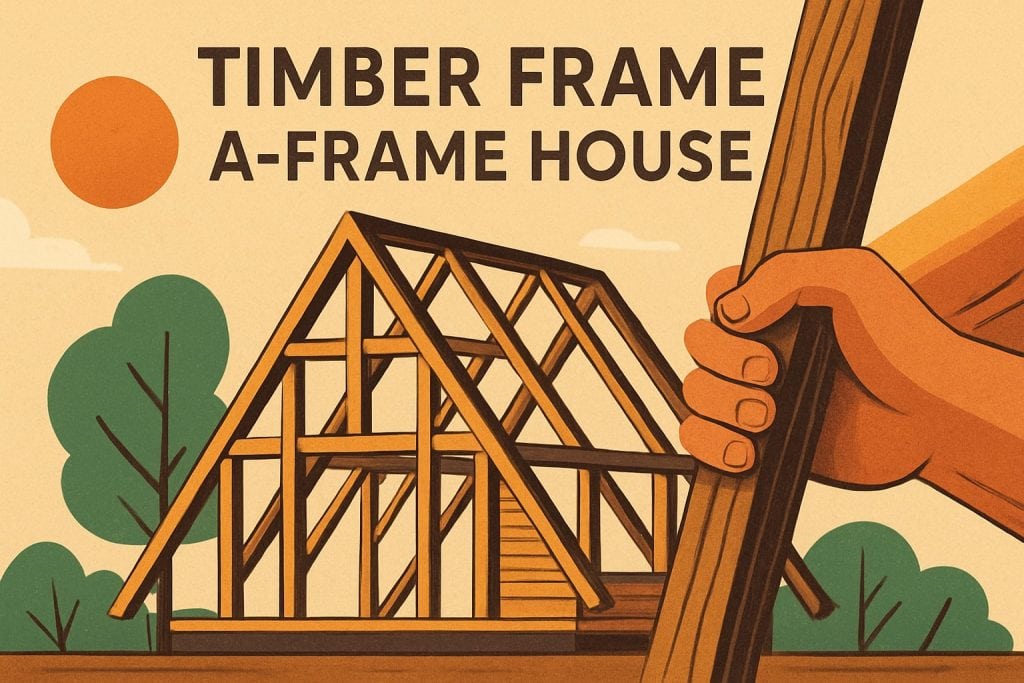The timber frame a frame house is taking centre stage for UK self-builders in 2025, combining timeless style with modern sustainability. Homeowners are drawn to the stunning triangular silhouette, open interiors, and the promise of lower energy bills.
If you dream of a bespoke, efficient, and visually striking home, this guide is for you. We will walk you through every step, from understanding A frame design to planning, materials, construction, sustainability, costs, and expert advice. Get ready to turn your vision into reality.
Understanding Timber Frame A Frame Houses
The timber frame a frame house is capturing the imagination of self builders across the UK. Its instantly recognisable triangular form and open, light filled interiors create a sense of both nostalgia and modern innovation. If you are considering a project in 2025, understanding the foundations of this unique architectural style is the first step towards designing a home that is both beautiful and highly efficient.
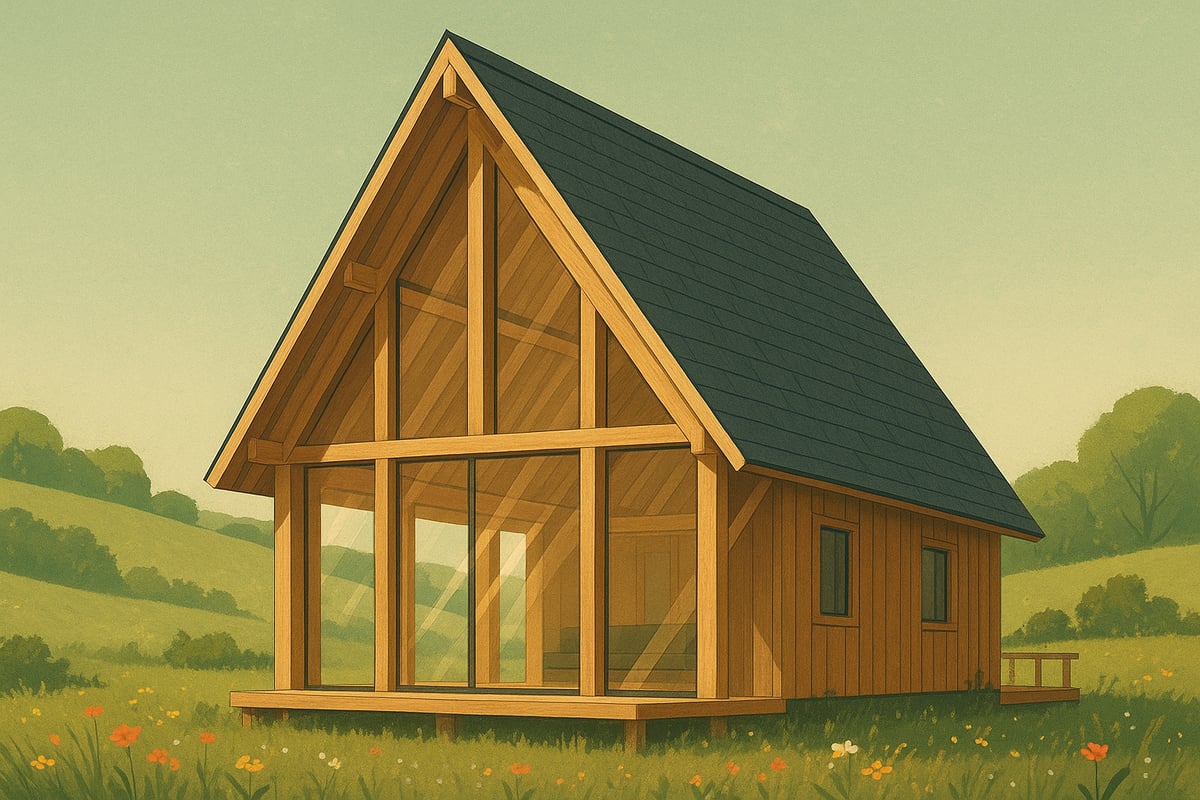
What is an A Frame House?
An A frame house is defined by its striking, triangular profile, formed by two steeply angled roof sides that meet at the apex and descend to the foundation. This iconic shape originated in postwar Europe and North America, evolving as a practical, cost effective solution for both holiday homes and permanent dwellings.
The timber frame a frame house takes full advantage of this design, using robust wooden beams to create wide, open plan interiors and soaring ceilings. The style’s simplicity makes it ideal for timber construction, allowing for quick assembly and strong, durable frameworks. In the UK, contemporary examples often feature floor to ceiling glazing and blend classic lines with modern materials. For a deeper dive into the history and construction of these homes, see the Timber frame and log homes guide.
Key Benefits of Timber Frame A Frame Houses
Choosing a timber frame a frame house offers a host of advantages for UK self builders. The efficiency of the triangular structure, with its minimal external wall area, results in excellent thermal performance and lower energy bills. Timber frames enable rapid build times compared to masonry, with many homes weather tight within weeks.
Design flexibility is another major plus, allowing you to tailor everything from open mezzanines to bespoke storage. Natural timber brings warmth and character, seamlessly connecting interior spaces with surrounding landscapes. With proper care, a timber frame a frame house can last for generations, combining visual impact with long term durability.
- Superior insulation from compact form
- Fast onsite construction
- Adaptable layouts and finishes
- Strong connection to nature
- Proven longevity with quality timber
Timber Frame vs. Other Build Methods
When weighing up a timber frame a frame house against SIPs, log homes, or conventional masonry, several differences emerge. Timber frames are typically more cost effective than masonry, with up to 30 percent shorter build times. Compared to SIPs, they offer greater flexibility for custom designs and modifications.
Log homes deliver a rustic look but often require more ongoing maintenance. Masonry builds, while solid, are heavier and less sustainable. Timber frames also outperform in terms of embodied carbon, making them a greener choice. For example, a recent UK project completed its timber frame a frame house in just six months, well ahead of equivalent brick builds.
| Build Method | Speed | Customisation | Sustainability | Maintenance |
|---|---|---|---|---|
| Timber Frame | Fast | High | Excellent | Low |
| SIPs | Fast | Moderate | Good | Low |
| Log Home | Moderate | Moderate | Good | Higher |
| Masonry | Slow | High | Low | Moderate |
Popular Design Trends for 2025
Looking ahead to 2025, the timber frame a frame house is evolving with new trends that enhance both style and performance. Expansive glazing is a must, flooding interiors with natural light and providing stunning views. Open mezzanines and loft spaces are increasingly popular, making the most of vertical volume and offering flexible living zones.
Smart home technology is becoming standard, from automated lighting to remote heating controls. Eco friendly finishes, such as natural oils and recycled materials, are topping wish lists as sustainability moves to the forefront. Modular and prefabricated elements are also gaining ground, making the timber frame a frame house more accessible and affordable for all.
Planning Your Timber Frame A Frame House
Embarking on a timber frame a frame house project requires careful planning from the outset. Each stage, from selecting the right plot to finalising your schedule, directly impacts your success. Below, we guide you through the essential planning steps for a seamless self-build journey.
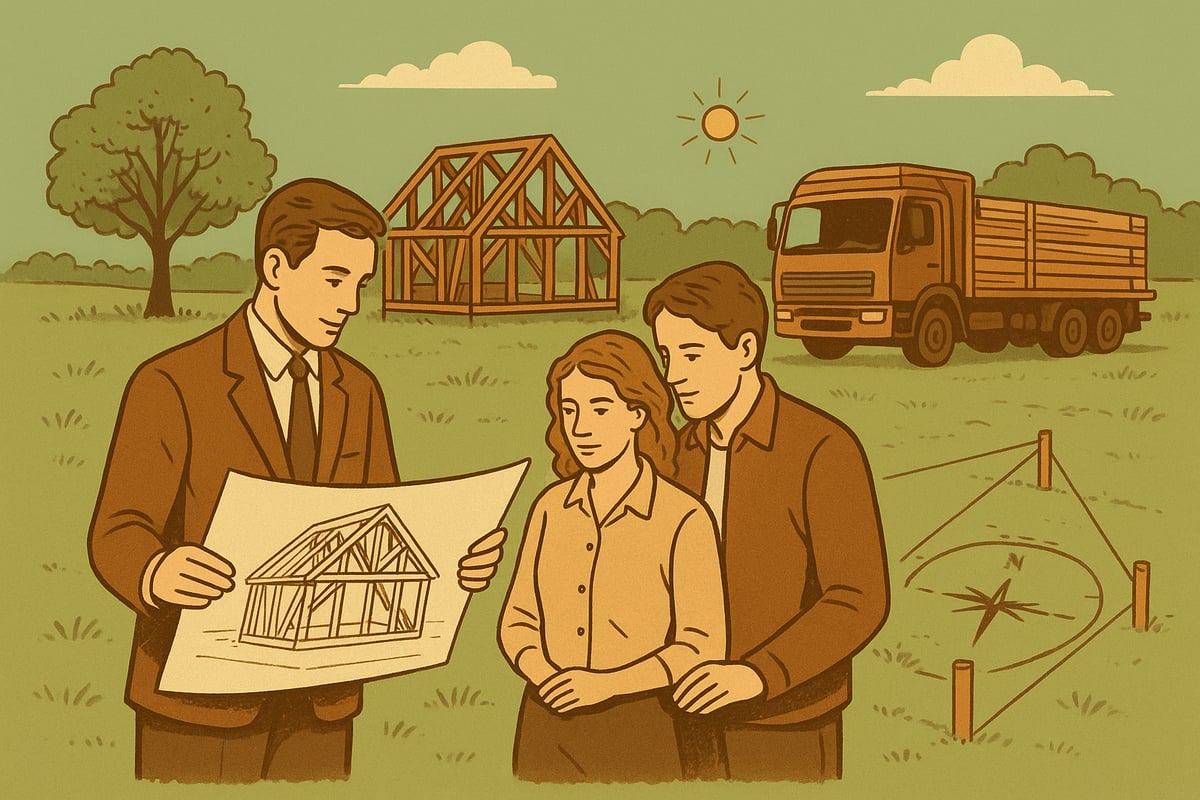
Site Selection and Orientation
Choosing the perfect site is the foundation for a successful timber frame a frame house. Prioritise plots with optimal sunlight exposure, particularly to the south, to enhance natural light and energy efficiency.
Evaluate access for large timber deliveries, especially if your site is rural or has narrow lanes. Plan for suitable groundworks and drainage to protect your future home from water ingress. In urban areas, consider privacy and the impact of neighbouring buildings on views and shade.
- Maximise sunlight and scenic outlooks
- Ensure site access for timber components
- Assess drainage and ground stability
By balancing these factors, you lay the groundwork for a comfortable and durable timber frame a frame house.
Navigating UK Planning Permission and Building Regulations
Securing planning permission is a pivotal step for your timber frame a frame house. Begin by consulting your local authority’s planning portal to understand requirements. Submit detailed drawings that showcase the unique A frame form and demonstrate compliance with local character and landscape guidelines.
Building regulations focus on structural safety, fire performance, insulation, and ventilation. Timber frame a frame house projects must meet standards for timber construction, including fire resistance and structural calculations. Prepare to address concerns about appearance, height, or materials, especially in conservation areas.
- Research local planning rules early
- Prepare comprehensive design documents
- Engage with building control officers
Staying proactive helps avoid delays and ensures your timber frame a frame house fits community expectations.
Creating Your Design Brief
A well-crafted design brief translates your lifestyle into a functional timber frame a frame house. Define your space needs: do you prefer open-plan living, separate zones, or a blend? Consider how you’ll use mezzanines, lofts, and storage to maximise the A frame’s unique geometry.
Sketch your ideal floor plan, balancing bedrooms, social spaces, and utility areas. Popular layouts for couples, families, or holiday lets each have distinct requirements. For inspiration, explore this Timber Frame House Case Study, showcasing a bespoke UK build that prioritises comfort and energy performance.
By clarifying your goals, you set a clear path for your timber frame a frame house project.
Working with Architects and Designers
Selecting an architect with timber frame a frame house expertise is essential. Look for professionals with a portfolio of similar projects, as they will anticipate the unique structural and aesthetic needs of A frames.
Embrace 3D modelling and virtual walkthroughs to visualise your design before construction. This collaborative approach ensures your vision aligns with technical requirements and planning constraints.
- Review past A frame projects
- Use digital tools for design clarity
- Maintain open communication throughout
A strong partnership with your architect leads to a timber frame a frame house that is both beautiful and practical.
Budgeting and Cost Planning
Accurate budgeting is vital for a successful timber frame a frame house build. In 2025, expect costs between £1,800 and £2,800 per square metre, depending on specification and location. Separate your budget into design fees, planning and surveys, materials, labour, and fit-out.
Factor in site-specific costs such as access improvements or foundation requirements. Allow a contingency fund for unforeseen expenses. Prefabricated timber components can streamline the process, often saving on labour and reducing waste.
Typical cost breakdown:
- Design and planning: 10–15%
- Materials: 30–40%
- Labour: 35–45%
- Fit-out and finishes: 10–15%
With careful planning, your timber frame a frame house can deliver value and peace of mind.
Project Timeline and Scheduling
Understanding your project’s timeline helps you manage expectations and logistics. The average timber frame a frame house journey, from design to move-in, spans 6 to 12 months.
Key milestones include planning approval, detailed design, off-site timber manufacture, on-site assembly, and final fit-out. Using a Gantt chart or project management tool can clarify dependencies and highlight potential bottlenecks.
Typical timeline:
| Stage | Duration |
|---|---|
| Design & Planning | 2–3 months |
| Manufacturing | 1–2 months |
| On-site Assembly | 1–2 months |
| Fit-out & Completion | 2–5 months |
By scheduling each phase thoughtfully, you help ensure your timber frame a frame house is delivered on time and within budget.
Choosing the Right Materials and Timber Frame Systems
Selecting the right materials and systems is essential for a successful timber frame a frame house. Every choice, from timber species to construction technique, influences cost, performance, and long-term satisfaction. Let us break down the options so you can make informed decisions at each stage.

Timber Species and Sourcing
The character and longevity of a timber frame a frame house start with the choice of timber. Common species include:
- Oak: Known for strength and beautiful grain, often used for both structure and finish.
- Douglas fir: Lightweight, stable, and cost-effective, ideal for large spans.
- Larch: Naturally resistant to decay, popular for external cladding and framing.
Using UK-grown timber supports local forestry and reduces transportation emissions. However, imported options can offer consistency and unique properties. Always seek FSC or PEFC certification for sustainability. Oak remains a favourite for those desiring a classic look and robust frame.
Timber Frame Construction Methods
There are two main methods for building a timber frame a frame house: post and beam, and platform framing. Post and beam uses large upright posts and horizontal beams, creating open interiors and exposed timber features. Platform framing employs smaller, repeated elements, often prefabricated into panels for rapid assembly.
Prefabricated panels can reduce on-site construction time by up to 40 percent, making them a smart choice for efficiency. Each method has pros and cons regarding flexibility, cost, and appearance. For a detailed breakdown of available options, see Timber frame products explained. Choosing the right system ensures your build suits both your vision and practical requirements.
Insulation, Glazing, and Envelope Performance
A high-performance envelope is crucial for a timber frame a frame house aiming to meet or exceed UK energy standards. Options for insulation include mineral wool, wood fibre, and high-density rigid boards. Super-insulating the walls and roof helps improve U-values and airtightness.
Double or triple glazing is recommended for large window areas, balancing cost and thermal performance. Many self-builders pursue Passive House standards, achieving exceptional comfort and up to 80 percent lower heating bills. Investing in quality insulation and glazing pays off in year-round comfort and energy savings.
Roofing, Cladding, and Weatherproofing
The steep roof of a timber frame a frame house demands careful material selection. Popular roofing options include standing seam metal, natural slate, and timber shingles, each providing durability and weather resistance. For cladding, timber boards, composites, or metal panels are frequently chosen to complement the frame’s natural aesthetic.
Proper detailing is key for ventilation and moisture control, especially in the UK’s damp climate. Regular maintenance, such as treating timber and inspecting seals, will extend your home’s lifespan and preserve its appearance.
Interior Finishes and Customisation
The interior of a timber frame a frame house is defined by exposed beams, open-plan spaces, and creative use of volume. Many homeowners opt for timber floors, wood-panelled walls, and bespoke staircases to highlight the frame’s beauty.
Built-in furniture, lofts, and mezzanines maximise space and storage, especially in compact designs. Custom joinery can transform under-eaves areas into functional nooks. Whether your style is rustic or modern, the flexibility of timber allows you to create a truly bespoke living environment.
Step-by-Step: Building Your Timber Frame A Frame House
Building a timber frame a frame house is a rewarding journey, transforming a vision into a distinctive, energy-efficient home. Each phase, from groundwork to final inspection, demands precision, planning, and attention to detail. To help you navigate the process, we break down the essential steps, offering practical guidance to ensure your project runs smoothly.
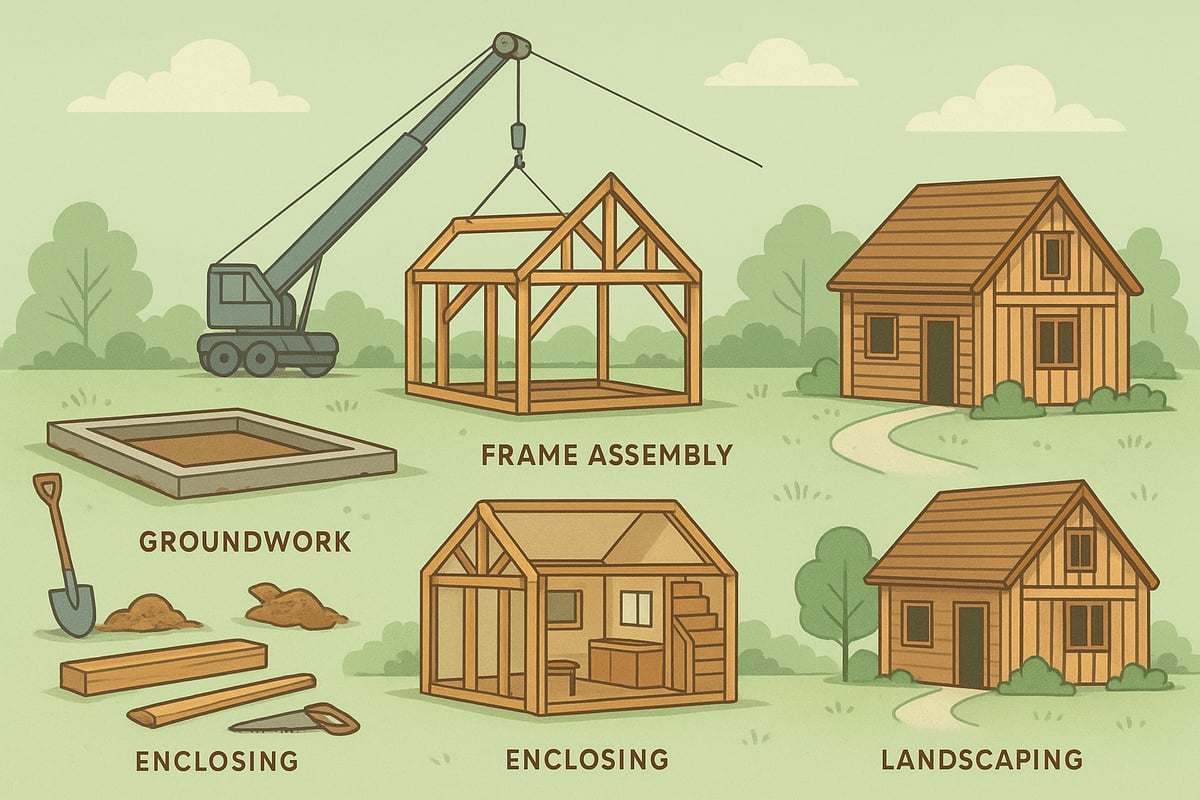
Step 1: Groundworks and Foundations
The first step in any timber frame a frame house build is preparing the site and laying robust foundations. Your choice of foundation—concrete slab, piles, or pads—will depend on soil conditions, site topography, and local regulations.
Proper site clearance and levelling are crucial. Drainage solutions must be incorporated early to prevent water ingress and protect the timber structure. Insulation at ground level is also installed at this stage, reducing heat loss from the base.
Minimal impact foundation systems are popular for woodland or rural settings, preserving natural habitats. Access for large timber components should be considered from the outset, ensuring smooth delivery and installation.
Step 2: Timber Frame Assembly
With foundations complete, the next phase involves assembling the timber frame a frame house. Timber components are delivered, stored securely, and then erected in a precise sequence.
Key joining techniques include mortise and tenon or steel connectors, ensuring both structural integrity and aesthetic appeal. Safety protocols are paramount, especially when working at height or with heavy beams.
Frame assembly typically takes just a few days for prefabricated systems, thanks to accurate manufacturing. For a deeper dive into this critical phase, the Framed home construction process offers an excellent step-by-step resource.
Step 3: Enclosing the Structure
Next, the timber frame a frame house is enclosed to create a weathertight shell. Roof and wall panels—often pre-insulated—are installed, followed by breathable membranes for airtightness and moisture management.
Windows and doors are fitted at this stage, taking care to seal all openings effectively. Achieving a rapid, weatherproof enclosure allows internal works to proceed without delay, protecting the timber from the elements.
A well-sealed envelope is essential for energy efficiency and comfort, setting the stage for subsequent installations.
Step 4: First Fix and Services
Once the structure is secure, the first fix stage begins within the timber frame a frame house. This step involves routing plumbing, electrical wiring, and heating systems through the frame.
If you’re integrating renewables—such as solar panels or heat pumps—now is the time to coordinate their installation. Planning for smart home features, including lighting, heating controls, and security, can future-proof your living space.
Underfloor heating is a popular choice, offering consistent warmth and complementing the open-plan design typically found in a frame homes.
Step 5: Internal Fit-Out
Internal fit-out brings your timber frame a frame house to life. Plasterboarding, painting, and adding interior cladding define the atmosphere and character of your home.
Kitchens, bathrooms, and storage solutions are installed, tailored to the unique angles and spaces of the a frame design. Floors, stairs, and balustrades are completed, often featuring custom joinery to maximise function and style.
Loft conversions and mezzanine levels are common, providing extra living space without expanding the building’s footprint.
Step 6: External Landscaping and Decking
The external environment is just as important as the interior in a timber frame a frame house. Thoughtful landscaping creates inviting outdoor living areas, with timber decking, patios, and carefully designed gardens enhancing the connection to nature.
Access paths and parking are incorporated to ensure functionality and kerb appeal. Seamless transitions between indoor and outdoor spaces are a hallmark of modern a frame design, often achieved with large sliding doors or wraparound decks.
Selecting durable, low-maintenance materials ensures your exterior remains attractive for years to come.
Step 7: Final Inspections and Handover
The final step in building your timber frame a frame house is securing building control sign-off and certification. This ensures compliance with all UK regulations and confirms the home is safe and ready for occupancy.
A thorough snagging process addresses any minor issues or adjustments needed post-build. You’ll receive handover documents, warranties, and a maintenance schedule to keep your home in top condition.
Regular aftercare, such as checking seals and timber treatments, will help preserve the integrity and value of your investment for decades.
Sustainability and Energy Efficiency in A Frame Timber Homes
Embracing sustainability is central to the appeal of a timber frame a frame house. These homes are designed to tread lightly on the environment while delivering impressive energy performance. Each aspect, from structure to systems, is an opportunity to reduce environmental impact and create a comfortable, future-proofed home.
Eco Credentials of Timber Frame Construction
The eco credentials of a timber frame a frame house are substantial. Timber is a renewable resource and, when sourced responsibly, has a much lower carbon footprint than concrete or brick. The embodied energy in timber is far less than that of traditional materials, and timber stores carbon throughout its lifespan.
Choosing certified timber, such as FSC or PEFC, assures responsible forestry and ethical supply chains. Lifecycle analysis shows timber frame homes can often be recycled at end of life, further improving their sustainability. For a deeper dive, see this resource on Sustainability in Timber Frame Builds.
Passive Design Principles for A Frames
A timber frame a frame house can achieve excellent energy efficiency by following passive design principles. Large south-facing glazing maximises solar gain, reducing heating demand in winter. Super-insulated walls, floors, and roofs help maintain a stable indoor temperature, while airtight construction minimises heat loss.
Natural ventilation strategies, such as opening clerestory windows at the apex, encourage airflow in summer. Timber’s thermal mass is lower than masonry, but with the right insulation, a timber frame a frame house can see up to 80% reduction in heating costs.
Renewable Technologies and Smart Systems
Integrating renewable technologies is straightforward in a timber frame a frame house. Solar PV panels on the steep roof pitch capture maximum sunlight, while air source or ground source heat pumps provide efficient heating and cooling. Battery storage systems can further increase energy independence.
Smart home technology, such as automated lighting, zoned heating, and security systems, is now frequently specified for these homes. The open-plan layout of a timber frame a frame house makes wiring and retrofitting new systems simple and cost-effective.
Maintenance and Longevity of Sustainable Homes
Regular maintenance is key to preserving the sustainability advantages of a timber frame a frame house. Natural treatments, such as oil or wax, protect timber from moisture and pests without harmful chemicals. Routine checks for weathering, especially on exposed timber, ensure longevity.
Upgrading insulation or renewable systems over time is straightforward thanks to the accessible structure. Case studies show that a well-built timber frame a frame house can remain efficient and attractive after 25 years, often requiring only minimal repairs and updates.
Cost Breakdown and Financing Your Build
Understanding the financial side of a timber frame a frame house project is crucial for a successful self-build. From initial design fees to ongoing value, careful planning can help you avoid surprises and make the most of your investment.
Upfront Costs: Design, Materials, Labour
When planning your timber frame a frame house, it is vital to understand where your money goes. Here is a typical cost breakdown for a three-bedroom build:
| Cost Element | Typical Percentage | Example Value (£) |
|---|---|---|
| Design & Fees | 10–15% | 20,000–30,000 |
| Timber Frame | 25–35% | 50,000–70,000 |
| Labour | 25–30% | 50,000–60,000 |
| Fit-Out | 20–25% | 40,000–50,000 |
Prefabricated timber frame systems can offer savings on labour and time, reducing overall costs. Always factor in planning fees, surveys, and contingencies specific to your site. The timber frame a frame house approach is often more cost-effective than traditional masonry.
Running Costs and Long-Term Value
The timber frame a frame house is celebrated for its energy efficiency and low maintenance. High-performance insulation, airtight construction, and quality glazing mean lower heating bills over the years. According to experts, timber frame homes can command a 10% premium in some UK markets because of their eco credentials and striking design.
Maintenance costs are typically lower compared to brick or block homes, especially with modern finishes. For more details on the efficiency and sustainability benefits, see Timber Frame Construction Benefits. The long-term value of a timber frame a frame house extends beyond energy savings to include strong resale potential.
Financing Options and Grants
Financing your timber frame a frame house can be achieved through self-build mortgages, which release funds in stages as your project progresses. Eligibility often depends on a solid business plan, planning permission, and a clear payment schedule.
Several government incentives support sustainable builds, such as VAT relief for new homes and green grants for eco-friendly systems. It is wise to consult with self-build finance specialists who understand the unique needs of timber frame projects. Staged payment schedules help manage cash flow during construction.
Managing Budget and Avoiding Hidden Costs
To stay on top of your timber frame a frame house budget, allow for site-specific extras like challenging access, landscaping, or bespoke finishes. Timber price fluctuations can impact your overall spend, so fixed-price contracts are recommended.
Clear communication with your builder and architect helps prevent unexpected bills. If future expansion is likely, planning with flexibility in mind is key. For those considering later additions, Understanding timber extensions is a valuable resource for future-proofing your investment and avoiding costly changes down the line.
Expert Tips and Common Pitfalls to Avoid
Building a timber frame a frame house is a rewarding journey, but it comes with unique challenges. Learning from experts can help you avoid common mistakes and achieve a home that is beautiful, efficient, and built to last.
Design and Space Optimisation
Making the most of your timber frame a frame house starts with smart design. The steep roof creates a striking look but can limit usable space. Focus on:
- Clever built-in storage in eaves and under stairs.
- Multi-use areas, such as lofts or mezzanine levels.
- Open-plan layouts to maximise natural light.
Avoid wasting space by planning furniture placement early. Use 3D models to visualise how rooms will feel. A timber frame a frame house can feel much larger when every corner is functional. Consult with your architect about integrating flexible spaces that adapt as your needs change.
Construction and Project Management Insights
Choosing experienced contractors for your timber frame a frame house is crucial. Timber construction requires specialist skills, so look for teams with proven expertise. Clear communication between you, your architect, and your builder keeps the project on track.
Most delays stem from poor coordination or unclear timelines. Use a detailed schedule, and hold regular site meetings to resolve issues quickly. Familiarising yourself with timber framing overview can help you speak confidently with your team about techniques and expectations.
Keep in mind that sequencing trades efficiently reduces downtime. Early planning for deliveries and storage of timber components ensures smooth assembly.
Regulatory and Warranty Considerations
Before you start your timber frame a frame house, confirm all plans meet UK building regulations. These rules cover everything from fire safety to insulation standards. Work closely with your designer to address requirements early and avoid costly changes.
Secure a structural warranty to protect your investment. Most lenders require this, and it provides peace of mind. If your build is in a conservation area, expect extra scrutiny and possible restrictions. Stay proactive with local authorities and document every approval.
Planning conditions may include landscaping or access stipulations. Keep all paperwork organised for inspections and future resale.
Future-Proofing Your A Frame Home
Design your timber frame a frame house with an eye to the future. Flexible layouts allow for easy modifications or extensions as your needs evolve. Consider installing conduit for future tech upgrades or renewable energy systems.
Choose materials and finishes that are durable and easy to update. If accessibility is a concern, include wide doorways and ground-floor facilities. Retrofitting features like solar panels or battery storage is simpler when planned from the outset.
A future-proofed timber frame a frame house adapts with you, maintaining value and comfort for years to come.
Ready to turn your vision of a striking, energy efficient timber frame A frame house into reality? Throughout this guide, we have explored everything from design inspiration and planning essentials to construction techniques and sustainability tips, all tailored for the UK self builder. With careful attention to detail and expert advice, you can achieve a home that is both beautiful and built to last. If you feel inspired to begin your own bespoke project, I invite you to take the next step and BUILD NOW with Acorn to Oak Framing’s dedicated team.
